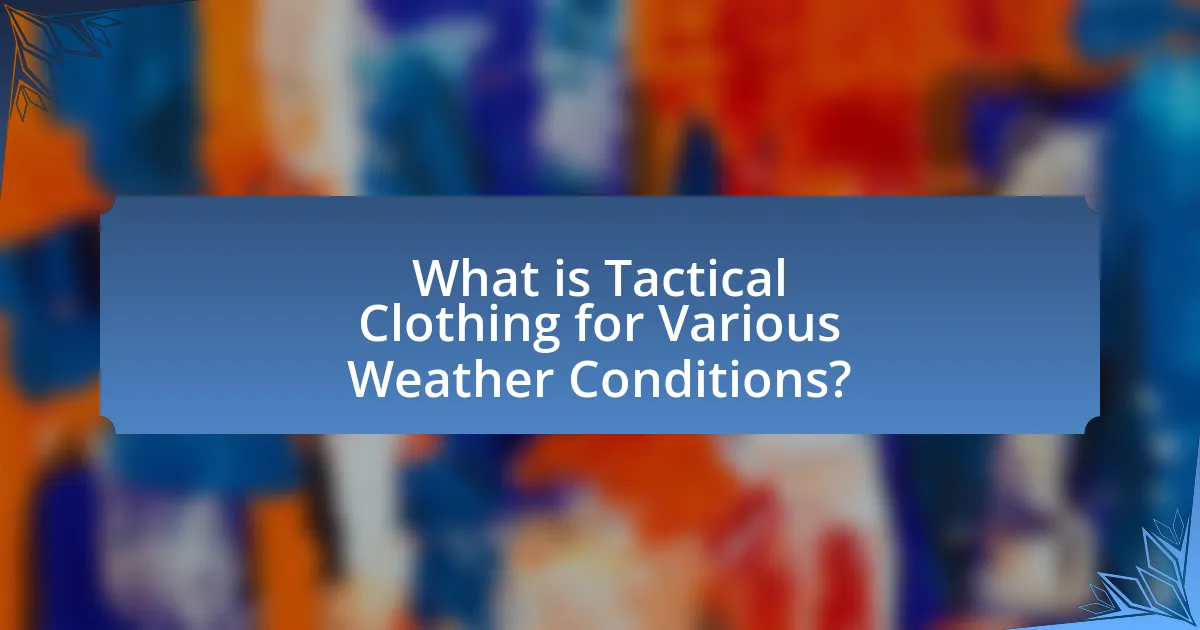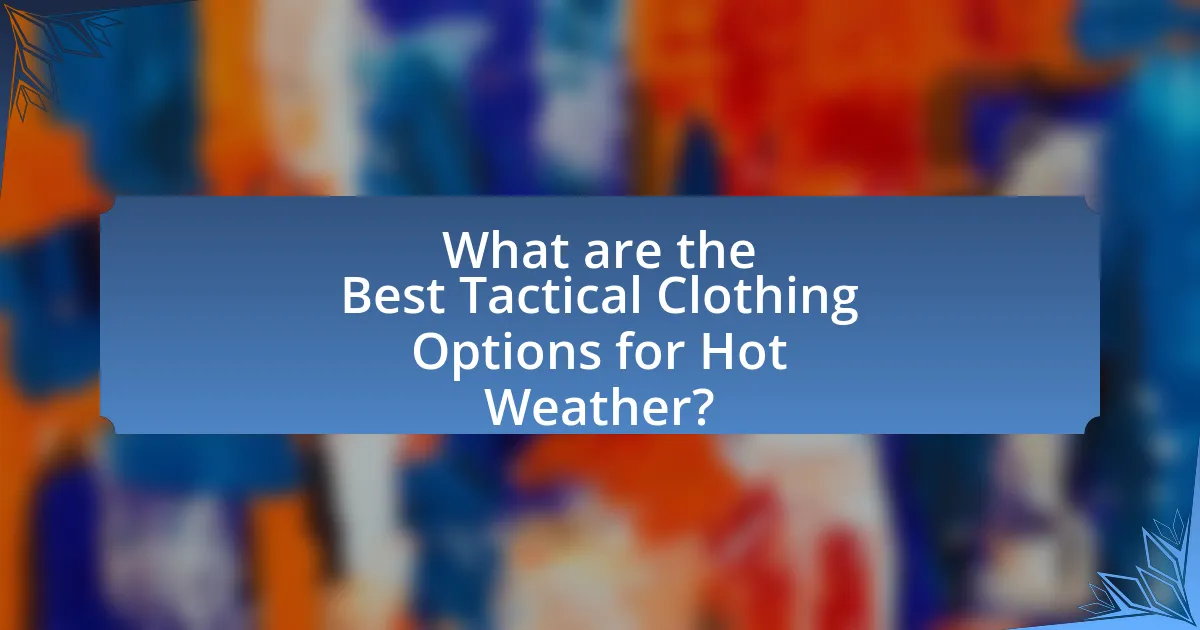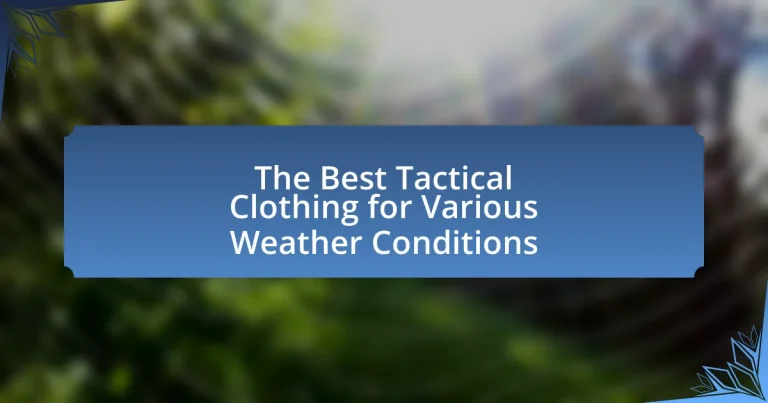The article focuses on the best tactical clothing options for various weather conditions, emphasizing the importance of functionality, protection, and comfort. It details how tactical clothing differs from regular apparel, highlighting features such as moisture-wicking fabrics for hot weather, insulated layers for cold conditions, and waterproof materials for rainy environments. The article also discusses the materials commonly used in tactical clothing, the significance of design in enhancing functionality, and the critical factors to consider when selecting clothing based on specific weather conditions. Additionally, it reviews top-rated tactical clothing brands and products suitable for extreme temperatures and wet conditions, providing practical insights for military, law enforcement, and outdoor enthusiasts.

What is Tactical Clothing for Various Weather Conditions?
Tactical clothing for various weather conditions refers to specialized apparel designed to provide functionality, protection, and comfort in diverse environmental scenarios. This type of clothing typically includes moisture-wicking fabrics for hot weather, insulated layers for cold conditions, and waterproof materials for wet environments. For instance, tactical jackets often feature breathable membranes to prevent overheating while maintaining water resistance, ensuring that users remain dry and comfortable. Additionally, tactical pants may incorporate reinforced knees and pockets for utility, adapting to both warm and cold climates. The effectiveness of tactical clothing is supported by its use in military and outdoor activities, where performance in extreme weather is critical.
How does tactical clothing differ from regular clothing?
Tactical clothing differs from regular clothing primarily in its design and functionality, as tactical clothing is specifically engineered for durability, versatility, and performance in demanding environments. Unlike regular clothing, which often prioritizes style and comfort, tactical clothing incorporates features such as reinforced seams, moisture-wicking fabrics, and multiple pockets for utility. For example, tactical pants often include features like knee pads and adjustable waistbands, which are not typically found in standard pants. This specialized construction is intended to withstand harsh conditions and provide ease of movement, making tactical clothing suitable for military, law enforcement, and outdoor activities.
What materials are commonly used in tactical clothing?
Tactical clothing commonly utilizes materials such as nylon, polyester, and cotton blends. Nylon is favored for its durability and resistance to abrasion, making it ideal for rugged environments. Polyester offers moisture-wicking properties and quick-drying capabilities, enhancing comfort during physical activities. Cotton blends provide breathability and comfort, although they may not perform as well in wet conditions. These materials are selected based on their ability to withstand various weather conditions and provide functionality for tactical operations.
How does the design of tactical clothing enhance functionality?
The design of tactical clothing enhances functionality by incorporating specialized materials and features that improve performance in diverse environments. Tactical clothing often utilizes moisture-wicking fabrics, which help regulate body temperature and keep the wearer dry during physical activity. Additionally, the inclusion of reinforced stitching and durable materials increases the longevity and resilience of the garments, making them suitable for rigorous use. Features such as multiple pockets and adjustable components provide practical storage and adaptability, allowing users to carry essential gear efficiently. These design elements are critical for military personnel, law enforcement, and outdoor enthusiasts who require reliable and versatile clothing in various weather conditions.
Why is it important to choose tactical clothing based on weather conditions?
Choosing tactical clothing based on weather conditions is crucial for ensuring optimal performance and safety. Weather-specific clothing enhances comfort, mobility, and protection against environmental elements such as rain, wind, and extreme temperatures. For instance, moisture-wicking fabrics are essential in hot conditions to prevent overheating, while insulated materials are necessary in cold weather to maintain body heat. Studies show that appropriate clothing can significantly reduce the risk of hypothermia or heat-related illnesses, thereby improving overall effectiveness in tactical situations.
What are the key weather conditions to consider?
The key weather conditions to consider include temperature, humidity, precipitation, wind speed, and sunlight exposure. Temperature affects clothing insulation needs; for instance, cold temperatures require layers for warmth, while hot temperatures necessitate breathable fabrics. Humidity influences comfort levels; high humidity can lead to overheating, making moisture-wicking materials essential. Precipitation, such as rain or snow, dictates the need for waterproof or water-resistant clothing to maintain dryness. Wind speed impacts thermal comfort; high winds can increase heat loss, necessitating windproof layers. Lastly, sunlight exposure requires UV protection in clothing to prevent skin damage. Each of these conditions plays a critical role in selecting appropriate tactical clothing for outdoor activities.
How does weather impact the performance of tactical clothing?
Weather significantly impacts the performance of tactical clothing by influencing its material properties, insulation, breathability, and moisture management. For instance, in cold weather, tactical clothing made from insulating materials retains body heat, while in hot weather, breathable fabrics facilitate airflow and wick moisture away from the skin. Research indicates that moisture-wicking fabrics can reduce sweat accumulation by up to 50%, enhancing comfort and performance during physical activities. Additionally, waterproof materials are essential in rainy conditions to prevent water penetration, ensuring that the wearer remains dry and maintains mobility. Thus, the effectiveness of tactical clothing is directly correlated with its ability to adapt to varying weather conditions, ensuring optimal performance and comfort.

What are the Best Tactical Clothing Options for Cold Weather?
The best tactical clothing options for cold weather include insulated jackets, moisture-wicking base layers, thermal pants, and waterproof outer shells. Insulated jackets, such as those made with down or synthetic insulation, provide essential warmth, while moisture-wicking base layers help regulate body temperature and keep sweat away from the skin. Thermal pants offer additional warmth and comfort, and waterproof outer shells protect against wind and precipitation. These clothing types are designed to maintain functionality and mobility in cold conditions, ensuring that tactical operations can be conducted effectively.
What features should cold weather tactical clothing have?
Cold weather tactical clothing should have insulation, moisture-wicking properties, wind resistance, and durability. Insulation is crucial for retaining body heat in low temperatures, while moisture-wicking fabrics help manage sweat and keep the wearer dry, preventing hypothermia. Wind resistance is essential to protect against chilling winds, and durability ensures the clothing can withstand harsh conditions and rough use. For example, materials like Gore-Tex provide both waterproofing and breathability, making them ideal for cold weather tactical applications.
How do insulation and layering work in cold weather clothing?
Insulation and layering in cold weather clothing function by trapping body heat and creating a barrier against cold air. Insulation materials, such as down or synthetic fibers, retain warmth by minimizing heat loss, while layering involves wearing multiple clothing items to enhance thermal efficiency. The base layer wicks moisture away from the skin, the middle layer provides insulation, and the outer layer protects against wind and moisture. This system allows for flexibility and adaptability to varying temperatures and activity levels, ensuring optimal comfort and protection in cold environments.
What are the best materials for cold weather tactical clothing?
The best materials for cold weather tactical clothing include wool, fleece, and synthetic fabrics like polyester and nylon. Wool provides excellent insulation and moisture-wicking properties, making it effective in retaining heat even when wet. Fleece is lightweight, breathable, and offers good thermal insulation, making it ideal for layering. Synthetic fabrics, such as polyester and nylon, are durable, quick-drying, and often treated for water resistance, enhancing their performance in cold and wet conditions. These materials are commonly used in tactical clothing to ensure warmth, comfort, and functionality in harsh environments.
Which brands are known for their cold weather tactical clothing?
Brands known for their cold weather tactical clothing include Arc’teryx, 5.11 Tactical, and Under Armour. Arc’teryx is recognized for its high-performance outerwear designed for extreme conditions, utilizing advanced materials like Gore-Tex for waterproofing and insulation. 5.11 Tactical offers a range of cold weather gear that combines functionality with durability, often featuring thermal insulation and moisture-wicking properties. Under Armour is known for its innovative cold gear technology, which helps regulate body temperature and wick away sweat, making it suitable for cold weather activities. These brands have established reputations in the tactical clothing market, backed by their commitment to quality and performance in harsh environments.
What are the top-rated cold weather tactical jackets?
The top-rated cold weather tactical jackets include the 5.11 Tactical 3-in-1 Parka, the Arc’teryx LEAF Alpha Jacket, and the Condor Summit Soft Shell Jacket. The 5.11 Tactical 3-in-1 Parka is praised for its versatility, featuring a waterproof outer shell and a removable insulated liner, making it suitable for various cold conditions. The Arc’teryx LEAF Alpha Jacket is recognized for its high-performance materials and durability, providing excellent insulation and weather resistance. The Condor Summit Soft Shell Jacket is noted for its affordability and functionality, offering warmth and breathability with multiple pockets for tactical use. These jackets have been evaluated based on user reviews, expert recommendations, and performance in cold weather scenarios, confirming their status as top choices in the tactical clothing market.
How do cold weather tactical pants compare in terms of warmth and mobility?
Cold weather tactical pants provide enhanced warmth through insulation materials while maintaining a level of mobility suitable for active use. The insulation, often made from synthetic fibers or fleece linings, traps body heat, ensuring comfort in low temperatures. Additionally, these pants are designed with features such as articulated knees and stretch fabrics, which allow for a full range of motion. This combination of warmth and mobility is crucial for outdoor activities in cold environments, as it enables users to perform tasks effectively without sacrificing comfort.

What are the Best Tactical Clothing Options for Hot Weather?
The best tactical clothing options for hot weather include lightweight, moisture-wicking fabrics, such as polyester or nylon, which help regulate body temperature and enhance breathability. Tactical shirts with short sleeves and ventilation features, along with cargo shorts or lightweight tactical pants, provide comfort and mobility. Additionally, clothing with UV protection is beneficial for sun exposure. Research indicates that moisture-wicking materials can reduce sweat retention and improve comfort in high temperatures, making them ideal for tactical use in hot climates.
What characteristics make tactical clothing suitable for hot weather?
Tactical clothing suitable for hot weather is characterized by lightweight, breathable fabrics that promote airflow and moisture-wicking properties. These materials, such as nylon and polyester blends, help to keep the body cool by allowing sweat to evaporate quickly, reducing the risk of overheating. Additionally, tactical clothing designed for hot conditions often features UV protection to shield the skin from harmful sun exposure, as well as ventilation systems like mesh panels or zippered openings that enhance airflow. The incorporation of these features ensures that the clothing remains functional and comfortable during high-temperature activities, making it ideal for outdoor operations in warm climates.
How does moisture-wicking technology benefit hot weather clothing?
Moisture-wicking technology benefits hot weather clothing by effectively drawing sweat away from the skin to the fabric’s surface, where it can evaporate quickly. This process helps regulate body temperature and keeps the wearer dry, which is crucial in hot conditions. Studies have shown that fabrics designed with moisture-wicking properties can reduce the discomfort associated with perspiration, enhancing overall comfort and performance during physical activities in high temperatures. For instance, research published in the Journal of Textile Science indicates that moisture-wicking fabrics can lower skin temperature by up to 2 degrees Celsius compared to traditional cotton materials.
What types of fabrics are best for hot weather tactical clothing?
Lightweight, breathable fabrics such as cotton, linen, and moisture-wicking synthetic materials like polyester and nylon are best for hot weather tactical clothing. These fabrics allow for better air circulation and moisture management, which helps regulate body temperature and keep the wearer comfortable in high temperatures. For instance, polyester is known for its quick-drying properties, making it ideal for humid conditions, while cotton offers comfort and breathability. Additionally, tactical clothing often incorporates features like UV protection and antimicrobial treatments, enhancing the functionality of these fabrics in hot weather scenarios.
Which brands excel in providing hot weather tactical clothing?
Brands that excel in providing hot weather tactical clothing include 5.11 Tactical, Under Armour, and Tru-Spec. 5.11 Tactical is known for its lightweight, moisture-wicking fabrics that enhance breathability and comfort in high temperatures. Under Armour offers tactical apparel designed with advanced cooling technologies, such as their HeatGear line, which helps regulate body temperature. Tru-Spec provides a range of tactical clothing made from lightweight materials that are specifically engineered for hot weather conditions, ensuring durability and comfort. These brands are recognized for their commitment to quality and performance in extreme heat environments.
What are the best hot weather tactical shirts available?
The best hot weather tactical shirts available include the 5.11 Tactical Rapid Shirt, the Under Armour Tactical HeatGear Shirt, and the Tru-Spec 24-7 Series Tactical Shirt. These shirts are designed with moisture-wicking fabrics and breathable materials to enhance comfort in high temperatures. For instance, the 5.11 Tactical Rapid Shirt features a lightweight, quick-drying fabric that helps regulate body temperature, while the Under Armour Tactical HeatGear Shirt utilizes advanced moisture management technology to keep the wearer dry. The Tru-Spec 24-7 Series offers a blend of cotton and polyester for durability and breathability, making it suitable for hot weather conditions.
How do hot weather tactical shorts differ from regular shorts?
Hot weather tactical shorts differ from regular shorts primarily in their design and functionality, specifically tailored for outdoor activities and demanding environments. Tactical shorts are constructed from lightweight, moisture-wicking fabrics that enhance breathability and quick-drying capabilities, which are essential for comfort in high temperatures. In contrast, regular shorts may not prioritize these features, often using heavier materials that retain moisture and heat. Additionally, tactical shorts typically include multiple pockets and reinforced stitching for durability and utility, catering to the needs of individuals in active or tactical situations, whereas regular shorts generally have fewer pockets and less robust construction.

What are the Best Tactical Clothing Options for Rainy Weather?
The best tactical clothing options for rainy weather include waterproof jackets, moisture-wicking base layers, and durable waterproof pants. Waterproof jackets, such as those made with Gore-Tex or similar materials, provide essential protection against rain while allowing breathability. Moisture-wicking base layers help keep the skin dry by drawing sweat away from the body, which is crucial in maintaining comfort during physical activity in wet conditions. Durable waterproof pants, often reinforced at the knees and seat, offer additional protection and can be easily layered over other clothing. These options are designed to withstand harsh weather while ensuring mobility and comfort, making them ideal for tactical situations in rainy environments.
What features should be prioritized in rainy weather tactical clothing?
Rainy weather tactical clothing should prioritize waterproofing, breathability, and durability. Waterproofing ensures that the fabric repels water, keeping the wearer dry; materials like Gore-Tex are commonly used for this purpose. Breathability allows moisture from sweat to escape, preventing overheating and discomfort during physical activity. Additionally, durability is crucial for withstanding harsh conditions and wear, often achieved through reinforced seams and abrasion-resistant fabrics. These features collectively enhance performance and comfort in wet environments, making them essential for effective tactical clothing.
How does waterproofing technology work in tactical clothing?
Waterproofing technology in tactical clothing works primarily through the application of specialized membranes or coatings that prevent water penetration while allowing moisture vapor to escape. These membranes, such as Gore-Tex or similar materials, feature microscopic pores that are smaller than water droplets but larger than water vapor molecules, enabling breathability. For instance, Gore-Tex has been proven to provide a waterproof barrier while maintaining high levels of breathability, making it effective in various weather conditions. This technology is crucial for tactical clothing as it ensures that wearers remain dry and comfortable during operations in wet environments, enhancing performance and safety.
What are the best materials for rain-resistant tactical clothing?
The best materials for rain-resistant tactical clothing include Gore-Tex, nylon, and polyester. Gore-Tex is a waterproof and breathable fabric that effectively keeps moisture out while allowing sweat to escape, making it ideal for active use in wet conditions. Nylon is known for its durability and water-resistant properties, often treated with a DWR (Durable Water Repellent) finish to enhance its performance against rain. Polyester, similarly, is lightweight and quick-drying, often used in combination with other materials to improve water resistance. These materials are widely recognized in the tactical clothing industry for their effectiveness in providing protection against rain while maintaining comfort and functionality.
Which brands are recognized for their rainy weather tactical clothing?
Brands recognized for their rainy weather tactical clothing include Arc’teryx, 5.11 Tactical, and Helikon-Tex. Arc’teryx is known for its high-performance waterproof materials and innovative designs, making it a favorite among outdoor enthusiasts and professionals. 5.11 Tactical offers a range of waterproof jackets and pants that combine functionality with durability, catering to law enforcement and military personnel. Helikon-Tex provides affordable yet effective rain gear, designed for tactical use while ensuring comfort and mobility. These brands have established a reputation for quality and reliability in adverse weather conditions.
What are the top-rated rain jackets for tactical use?
The top-rated rain jackets for tactical use include the Arc’teryx LEAF Alpha Jacket, the 5.11 Tactical Rain Jacket, and the Helikon-Tex Mistral Jacket. The Arc’teryx LEAF Alpha Jacket is known for its Gore-Tex fabric, providing excellent waterproofing and breathability, making it suitable for extreme conditions. The 5.11 Tactical Rain Jacket features a durable water-repellent finish and multiple pockets for utility, ensuring functionality during operations. The Helikon-Tex Mistral Jacket is lightweight and packable, offering water resistance and windproof capabilities, ideal for tactical scenarios. These jackets are highly rated for their performance in adverse weather, durability, and tactical features.
How do rain pants enhance comfort and protection in wet conditions?
Rain pants enhance comfort and protection in wet conditions by providing a waterproof barrier that keeps the wearer dry and insulated from cold, wet environments. This barrier is typically achieved through materials like Gore-Tex or similar waterproof fabrics, which prevent water penetration while allowing moisture vapor to escape, thus reducing sweat accumulation. Additionally, rain pants often feature adjustable cuffs and elastic waistbands, which improve fit and prevent water from entering, further enhancing comfort. The combination of these features ensures that individuals remain comfortable and protected during outdoor activities in inclement weather.
What are some tips for selecting the right tactical clothing for varying weather conditions?
To select the right tactical clothing for varying weather conditions, prioritize materials that offer breathability, insulation, and water resistance. For hot weather, choose lightweight, moisture-wicking fabrics that allow airflow, such as polyester or nylon blends. In cold conditions, opt for layered clothing, including thermal base layers and insulated outer layers, to retain body heat while allowing for moisture management. For wet environments, select garments with waterproof or water-resistant coatings, such as Gore-Tex, to keep dry. Additionally, consider features like adjustable ventilation, reinforced seams, and pockets for functionality. These choices are supported by industry standards that emphasize the importance of adaptability in tactical gear for optimal performance across different climates.
How can layering improve adaptability to changing weather?
Layering improves adaptability to changing weather by allowing individuals to adjust their clothing according to temperature fluctuations and environmental conditions. This method enables the wearer to add or remove layers as needed, maintaining comfort and thermal regulation. For instance, wearing a moisture-wicking base layer, an insulating mid-layer, and a waterproof outer layer provides versatility; the base layer keeps the skin dry, the mid-layer traps heat, and the outer layer protects against wind and rain. Studies show that layering can enhance thermal comfort by up to 30% in varying climates, demonstrating its effectiveness in adapting to diverse weather scenarios.
What are common mistakes to avoid when choosing tactical clothing for different climates?
Common mistakes to avoid when choosing tactical clothing for different climates include selecting inappropriate materials, neglecting layering options, and failing to consider breathability and moisture-wicking properties. Choosing materials that do not suit the climate can lead to discomfort; for example, heavy fabrics in hot weather can cause overheating, while lightweight materials in cold climates may not provide adequate insulation. Neglecting layering options can restrict adaptability to changing weather conditions, making it difficult to regulate body temperature. Additionally, failing to prioritize breathability and moisture-wicking properties can result in excessive sweat accumulation, leading to chafing and discomfort. These factors are critical for maintaining comfort and functionality in tactical situations across various environments.


